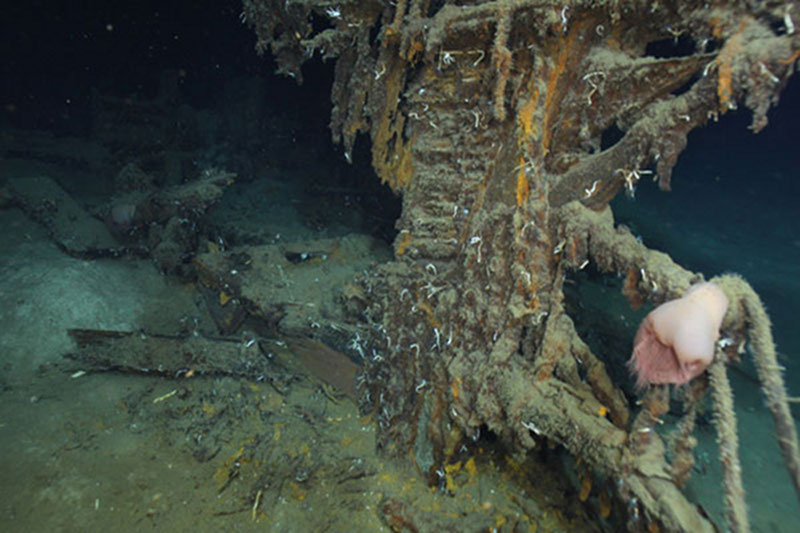
By Greg Boland - Bureau of Ocean Energy Management

The stem and beak of the 7,000 Foot shipwreck from the Lophelia Expedition in 2009. Image courtesy of Rob Church using the Aquapix camera, Lophelia II 2009: Deepwater Coral Expedition: Reefs, Rigs and Wrecks. Download image (jpg, 91 KB).
Since 2004, the funding agencies of this Deepwater Canyons project, the Bureau of Ocean Energy Management (BOEM), the National Oceanic and Atmospheric Administration’s Office of Ocean Exploration and Research (NOAA OER) and the U.S. Geological Survey (USGS) have partnered on a series of novel multi-disciplinary ocean research expeditions to explore and characterize poorly-known ecosystems in the Gulf of Mexico and now the Atlantic Ocean. Additional value has been gained by these agencies with the inclusion of a variety of academic and other partners. The unique nature of the partnerships enables each agency and institution to bring its expertise and resources together to create a successful and effective team for both exploration and providing necessary applied science for the management of energy resources. Previous partnering studies involving all three agencies and their other partners included:
Exploration and Research of Northern Gulf of Mexico Deepwater Natural and Artificial Hard Bottom Habitats with Emphasis on Coral Communities: Reefs, Rigs and Wrecks (received the National Oceanographic Partnership Program’s Excellence in Partnering for 2011)
Investigations of Chemosynthetic Communities on the Lower Continental Slope of the Gulf of Mexico (received the Department of Interior’s Partners in Conservation award in 2007).
In addition to the continuing strong partnership with NOAA OER, collaboration with USGS was incorporated into the study design of this new Atlantic Deepwater Canyons study from the earliest development of the project’s Statement of Work. This is the first time a BOEM study fully integrated USGS scientists as co-Principal Investigators within a contract to a private company using the same research vessel and other facilities. Partnerships maximize the utility of research results and extend limited budgets, enhancing the ability to achieve conservation goals of all agencies. All three of the Federal agencies participating fully recognize the fact that this research could not have succeeded otherwise.
Data gathered from this new study will provide essential information on the ecology and biodiversity of these deep-sea communities, including any shipwrecks discovered, to regulatory agencies for consideration in advance of any potential future energy development. The extensive and successful partnering exemplifies the best use of tax dollars and the use of best practices for interagency leveraging. The partnerships leveraged talent, funding, and physical assets that will result in a far more significant outcome than any individual agency could do on its own.